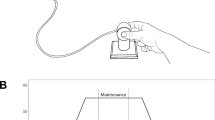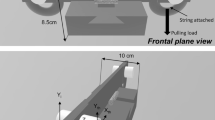Abstract
The aim of this study was to examine the development of underlying motor control strategies in young children by characterizing the changes in performance of a visually guided force regulation task using two different grip formations; a whole-hand power grip (developmentally easier) and a thumb-index finger precision grip (developmentally more advanced). Typically developing preschool children (n=50, 3.0–5.5 years) used precision and power grips to perform a ramp and hold task with their dominant and non-dominant hands. Participants performed five trials with each hand and grip holding the force at 30% of their maximum volitional contraction for 3 s. The data were examined for both age-related and performance-related changes in motor performance. Across ages, children increased in strength, decreased in initial overshoot of the target force level, and decreased in rate of force release. Results of a cluster analysis suggest non-linear changes in the development of force control in preschool children, with a plateau in (or maturation of) velocity measures (rate of force increase and force decrease) earlier than in amplitude-related measures (initial force overshoot and force variability).







Similar content being viewed by others
Notes
It is recognized that young children easily elicit contralateral motor overflow and/or bilateral activation; the output from each hand is not solely a unimanual activity. However, the children were just as likely to squeeze the other hand whether or not there was an object in it.
References
Barlow SM, Bradford PT (1992) Measurements and implications of orofacial muscle performance in speech disorders. J Hum Muscle Perform 1(4):1–31
Barlow S, Abbs J (1986) Fine force and position control of select orofacial structures in the upper motor neuron syndrome. Exp Neurol 94(3):699–713
Beenakker EA, van der Hoeven JH, Fock JM, Maurits NM (2001) Reference values of maximum isometric muscle force obtained in 270 children aged 4–16 years by hand-held dynamometry. Neuromuscul Disord 11(5):441–446
Blank R, Heizer W, von Voss H (1999) Externally guided control of static grip forces by visual feedback-age and task effects in 3–6-year old children and in adults. Neurosci Lett 271(1):41–44
Blank R, Heizer W, von Voss H (2000) Development of externally guided grip force modulation in man. Neurosci Lett 286(3):187–190
Darrah J, Hodge M, Magill-Evans J, Kembhavi G (2003) Stability of serial assessments of motor and communication abilities in typically developing infants—implications for screening. Early Hum Dev 72(2):97–110
Deutsch KM, Newell KM (2001) Age differences in noise and variability of isometric force production. J Exp Child Psychol 80(4):392–408
Deutsch KM, Newell KM (2002) Children’s coordination of force output in a pinch grip task. Dev Psychobiol 41(3):253–264
Deutsch KM, Newell KM (2003) Deterministic and stochastic processes in children’s isometric force variability. Dev Psychobiol 43(4):335–345
Deutsch KM, Newell KM (2004) Changes in the structure of children’s isometric force variability with practice. J Exp Child Psychol 88(4):319–333
Ericsson KA, Krampe RT, Tesch-Romer C (1993) The role of deliberate practice in the acquistion of expert performance. Psychol Rev 100(3):363–406
Fietzek UM, Heinen F, Berweck S, Maute S, Hufschmidt A, Schulte-Monting J, Lucking CH, Korinthenberg R (2000) Development of the corticospinal system and hand motor function: central conduction times and motor performance tests. Dev Med Child Neurol 42(4):220–227
Forssberg H, Eliasson AC, Kinoshita H, Johansson RS, Westling G (1991) Development of human precision grip I: basic coordination of force. Exp Brain Res 85:451–457
Forssberg H, Kinoshita H, Eliasson AC, Johansson RS, Westling G, Gordon AM (1992) Development of human precision grip II: anticipatory control of isometric forces targeted for object’s weight. Exp Brain Res 90:393–398
Heinen F, Fietzek UM, Berweck S, Hufschmidt A, Deuschl G, Korinthenberg R (1998) Fast corticospinal system and motor performance in children: conduction proceeds skill. Pediatr Neurol 19(3):217–221
Hook WE, Stanley JK (1986) Assessment of thumb to index pulp to pulp pinch grip strengths. J Hand Surg Br 11(1):91–92
Johansson BB (2004) Brain plasticity in health and disease. Keio J Med 53(4):231–246
Lazarus JA, Whitall J (1999) Motor overflow and children’s tracking performance: is there a link? Dev Psychobiol 35(3):178–187
Lazarus JAC, Whitall J, Franks CA (1995) Isometric force regulation in children. J Exp Child Psychol 60(2):245–260
Lexell J, Sjostrom M, Nordlund AS, Taylor CC (1992) Growth and development of human muscle: a quantitative morphological study of whole vastus lateralis from childhood to adult age. Muscle Nerve 15(3):404–409
Lin JP, Brown JK, Walsh EG (1994) Physiological maturation of muscles in childhood. Lancet 343(8910):1386–1389
Muller K, Ebner B, Homberg V (1994) Maturation of fastest afferent and efferent central and peripheral pathways: no evidence for a constancy of central conduction delays. Neurosci Lett 166(1):9–12
Muller K, Homberg V (1992) Development of speed of repetitive movements in children is determined by structural changes in corticospinal efferents. Neurosci Lett 144(1–2):57–60
National Instruments Corp (1998) Version 5.0 LabVIEW. Austin, TX
Pare M, Dugas C (1999) Developmental changes in prehension during childhood. Exp Brain Res 125(3):239–247
Parker KC, Mainland MK, Amdur JR (2001) Disc: Diagnostic Inventory for Screening Children Preschool Screen 3.0. St. Clements, ON: Mainland Consulting
Smits-Engelsman BC, Westenberg Y, Duysens J (2003) Development of isometric force and force control in children. Cogn Brain Res 17(1):68–74
Todor JI, Lazarus JA (1986) Exertion level and the intensity of associated movements. Dev Med Child Neurol 28(2):205–212
Touwen BCL (1978) Variability and stereotypy in normal and deviant development. In: Apley J (ed) Care of the handicapped child. Heinemann, London, pp 99–110
Yakolev PI, Lecours AR (1967) The myelogenetic cycles of regional maturation of the brain. In: Minkowski A (ed) Regional development of the brain in early life. Blackwell, Oxford
Acknowledgments
This study was completed as a partial requirement for a Ph.D. by the first author at the University of Wisconsin-Madison.
Author information
Authors and Affiliations
Corresponding author
Appendix A: Force regulation parsing rules
Appendix A: Force regulation parsing rules
The following criteria were used to select the child’s best (most adult-like) trial for analysis.
First, select the trial that upon:
-
1.
Initial inspection inspect has a:
-
a.
Flat stability line.
-
b.
Rise time after go.
-
c.
Release time closest within 90 samples of stop. If more than one trial meets criteria number 1 then select the trial using the following criteria:
-
a.
-
2.
Stability:
-
a.
Flattest stability period:
-
1.
Least drops below target at −125 samples before the release.
-
2.
Least rises above target at −125 samples before the release.
-
3.
Longest stability period within task “go” and “stop” boundaries.
-
1.
-
a.
-
3.
Initiation:
-
a.
Straight rise line.
-
b.
Steepest slope.
-
c.
After “go”.
-
d.
Minimal overshoot on height.
-
a.
-
4.
Release:
-
a.
Straight release line.
-
b.
After “stop”. Include in the selection:
-
c.
10 samples before rise point or go, whichever comes first.
-
d.
10 samples after return to baseline or stop, whichever comes last.
-
a.
Rights and permissions
About this article
Cite this article
Potter, N.L., Kent, R.D., Lindstrom, M.J. et al. Power and precision grip force control in three-to-five-year-old children: velocity control precedes amplitude control in development. Exp Brain Res 172, 246–260 (2006). https://doi.org/10.1007/s00221-005-0322-5
Received:
Accepted:
Published:
Issue Date:
DOI: https://doi.org/10.1007/s00221-005-0322-5




